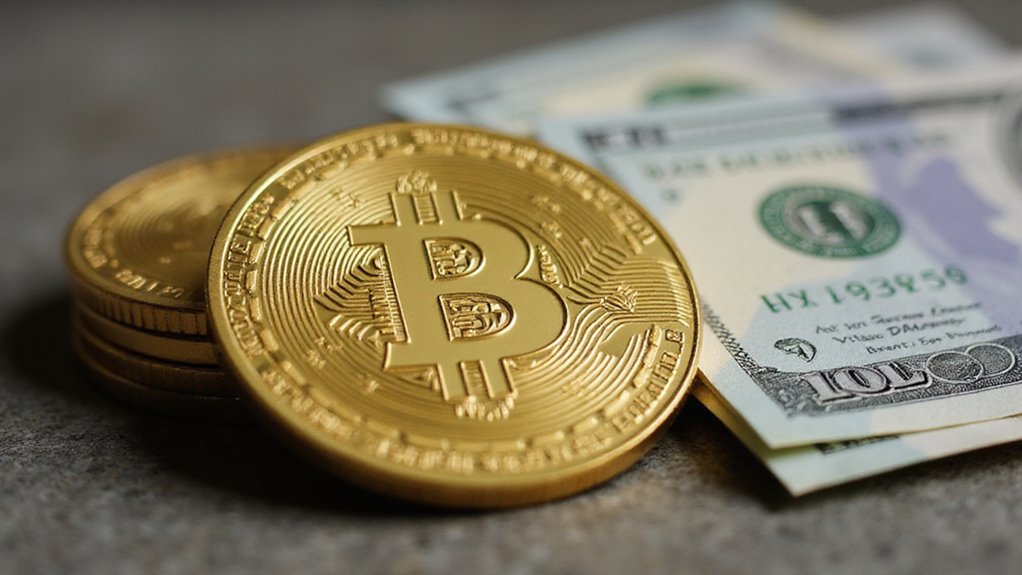Stablecoins represent a fascinating hybrid—marrying euro stability with blockchain efficiency while central banks watch nervously from the sidelines. Euro-pegged variants (EURC, EURT) leverage reserve assets to maintain value, enabling cross-border payments that bypass archaic Swift networks. With monthly transfer volumes hitting $4.1 trillion by 2025 and 28% year-over-year growth, these digital assets threaten traditional monetary control. The European Union’s contemplation of a digital euro reveals just how profoundly these private currencies have disrupted the financial chessboard.

How does the venerable euro—a two-decade pillar of European monetary integration—compare to its digital doppelgängers in the burgeoning stablecoin market?
The comparison reveals a fascinating convergence of traditional finance and blockchain innovation, where stability mechanisms differ fundamentally yet serve similar purposes.
Euro-pegged stablecoins like EURC, EURT, and EURCV maintain their value through reserve assets, offering the euro’s stability with blockchain’s efficiency—a proposition that would have seemed preposterous to central bankers merely a decade ago.
The stablecoin market continues its relentless expansion, with year-over-year growth averaging 28%, suggesting an appetite for instruments that bridge conventional banking with cryptocurrency’s nimbleness.
These digital assets facilitate cross-border payments with remarkable efficiency, circumventing the byzantine correspondent banking networks that have plagued international transfers since Swift’s inception in the 1970s. The stablecoin market reached an impressive $4.1 trillion in monthly transfer volumes by February 2025, demonstrating unprecedented adoption for this technology.
For eurozone businesses weary of conversion fees and settlement delays, this represents nothing short of a paradigm shift.
Meanwhile, the European Union contemplates its own central bank digital currency—the digital euro—ostensibly to preserve economic sovereignty in an increasingly digitized global economy.
This institutional response to privately-issued stablecoins (which, let’s be frank, threatens the monetary control central banks have jealously guarded) exemplifies how disruptive technologies ultimately compel adaptation from established systems.
Security and transparency mechanisms further distinguish these parallel monetary instruments.
While the euro relies on central bank credibility and regulatory frameworks, stablecoins leverage blockchain’s immutable ledger, allowing anyone to verify transactions and reserve holdings—a level of transparency inconceivable in traditional banking.¹
Smart contracts introduce automated compliance and risk management that make conventional banking protocols seem positively antediluvian by comparison.
Despite their promise, it’s important to note that market fluctuations may still impact stablecoins, especially if their underlying reserves prove insufficient during economic stress.
The competition between euro-pegged stablecoins and dollar-backed alternatives mirrors broader geopolitical currency rivalries, with implications for reserve currency status.
As policymakers deliberate regulatory approaches, users increasingly vote with their digital wallets, embracing whichever instrument best delivers the holy trinity of finance: stability, efficiency, and accessibility.
The global stablecoin landscape remains dominated by US dollar-pegged instruments, which contribute to the continued influence of American monetary policy despite declining dollar reserves worldwide.
Frequently Asked Questions
How Are Stablecoins Regulated Across Different Global Jurisdictions?
Stablecoin regulation varies dramatically across jurisdictions, reflecting differing priorities and regulatory philosophies.
The EU’s thorough MiCA framework contrasts with the US’s piecemeal approach (still coalescing through the STABLE and GENIUS Acts). Meanwhile, the UK develops payment-focused regulations, Singapore enforces strict licensing requirements, and Dubai enhances transparency standards.
This regulatory patchwork—ranging from proactive to reactive postures—creates a complex compliance landscape for issuers managing cross-border operations, with reserve requirements and consumer protections as common threads.
What Security Risks Do Stablecoins Face Compared to the Euro?
Stablecoins face multidimensional security challenges that the euro largely sidesteps.
While the euro enjoys institutional safeguards backed by central banks and regulatory frameworks refined over decades, stablecoins contend with smart contract vulnerabilities, oracle manipulation, and cybersecurity breaches.
Furthermore, stablecoins’ collateral dependencies create unique liquidity risks during market downturns.
The regulatory ambiguity surrounding these digital assets—unlike the euro’s clear legal standing—further compounds their security profile, leaving them susceptible to exploitation for illicit financial activities.
Can Stablecoins Function Effectively During Financial Crises?
Stablecoins face significant challenges during financial crises, as evidenced by de-pegging events like USDC during the Silicon Valley Bank collapse.
While theoretically designed for stability, they remain vulnerable to market panics, collateral deterioration, and liquidity crunches—precisely when stability is most needed.
Their effectiveness hinges on reserve quality, regulatory frameworks, and market confidence.
Ironically, these digital instruments created to provide refuge from volatility often succumb to the very turbulence they were designed to withstand.
How Do Transaction Speeds Compare Between Stablecoins and Euro Transfers?
Stablecoins outpace Euro transfers substantially in transaction speed.
While traditional SEPA transfers take one business day (and cross-border Euro transfers several days), stablecoins typically settle within seconds to minutes—regardless of time zones or banking hours.
Even the much-lauded “instant” SEPA payments, though competitive within their limited ecosystem, can’t match stablecoins’ global settlement efficiency.
The absence of intermediaries in stablecoin transfers eliminates the multi-bank verification delays that plague traditional Euro transfer systems, particularly in cross-border scenarios.
What Environmental Impact Do Stablecoins Have Versus Traditional Euro Systems?
Stablecoins typically generate a smaller environmental footprint than proof-of-work cryptocurrencies, operating primarily on proof-of-stake mechanisms that consume substantially less energy.
Traditional Euro systems, while avoiding blockchain’s computational demands, still incur substantial environmental costs through physical currency production, banking infrastructure, and transportation networks.
The distinction isn’t binary, however—as stablecoin adoption scales, so too might their collective impact, though they remain considerably more efficient per transaction than their volatile crypto counterparts.









